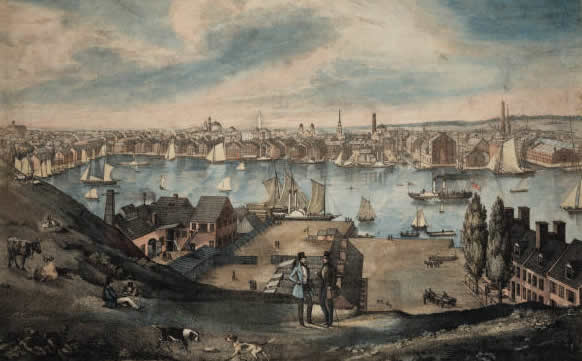 |
The city of Baltimore early 19th century
|
The Early Years 1828 to 1858
The B&O railroad started shortly after when America got its
independence. The B&O
railroad was created in 1828. It was originally made to compete with the Erie
Canal. At that time the president, John Quincy Adams, thought canals were the future for transporting goods across the country.
 |
| Chesapeake and Ohio canal mule powered boats |
The fast-growing port city faced economic crisis unless it opened new routes to markets in the western states such as New York had done with the Erie Canal in 1820. In 1827, leading merchants and bankers met to study the best means of "resoring portions of the Western trade wich has recently been diverted from it by the introduction of steam navigation." The group's answer to the problem was to build a railroad to the west.
 |
| The Laying of the First Stone of the B&O Railroad |
 |
| Early railroads were horse powered before steam was used |
The Baltimore and Ohio Railroad received its name from the
start of the railroad line in Baltimore, and its intended destination, the Ohio
River. The railroad had to go over high
rocky mountainous, crossing mainly undeveloped wilderness. Engineers had to design a railroad without
knowing the capabilities of the engines and cars that would run on them. The
engineers constructing the railroad had no blueprints to follow and many solutions
to construction problems were solved by trial and error as they went along. One
historian said that the challenge called the B&O's plans a
nineteenth-century version of the moon-shot. Their final success was a testament to their
skills and helped the railroad earn the informal title "The Railroad
University of America" as the knowledge they gained was used to build
other railroads.
 |
| Building a railroad over mountainous terrain posed new engineering problems to overcome |
Early B&O railroad trains and cars were the size of one of today's cars and could barely hold anything in them, and then they
began getting bigger to haul passengers and take people all around the United
States from east to west coast.
 |
| The engine Tom Thumb circa 1829 |
The
first railway in May, 1830 went west from Baltimore to Ellicott City.
 |
| The B&O Railroad station at Ellicot City |
 |
| Early B&O railroad growth |
 |
| Mountain construction for a new railroad bed |
 |
| Cumberland Maryland 1906 |
In June 1851 the B&O Railroad reached Cumberland. MD.

The B&O railroad had reached the Monongahela River at
Fairmont in June of 1852, finally arriving at Wheeling in January 1853.
 |
| Fairmont Virginia (later West Virginia) |
 |
| B&O Railroad 1858 |
 |
| B&O Railroad western expansion by 1874 |
1. An 1827 report shows the motivations of early boosters: Woody, William (1827). "Baltimore and Ohio Railroad Proceedings of sundry citizens of Baltimore convened for the Purpose of Devising the most efficient Means of Improving the Intercourse between that City and the Western States."The North American Review (Boston:Frederick T. Gray) 25 (56): 62-73.













